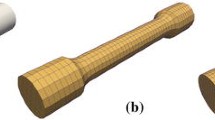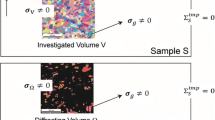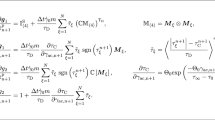Abstract
The accuracy of the stresses predicted from crystal plasticity-based finite element formulation depends on estimation and control of the errors associated with the discretization. In the current work, the errors in the stress distribution are estimated in virtual polycrystalline samples of α-phase titanium (hexagonal close-packed phase of Ti–6Al–4V). To estimate the error, the stress field, which does not possess inter-element continuity, is smoothed over a grain using an \(L_2\) projection, thereby providing continuous stress distributions with inter-element continuity. The differences between the continuous (smooth) and discontinuous (raw) stress fields are calculated at individual Gauss quadrature points and used to estimate errors for corresponding elements and grains. Error estimations are performed for a Voronoi-tessellated microstructure, an equiaxed microstructure, and two microstructures with varying grain sizes for tensile loading extending into the fully plastic regime (\(\approx \) 5% extension). Magnitudes of the errors are found to depend on microstructural characteristics, particularly the shape and size of grains. Samples having variations in grain size or having less spherical grains exhibited higher errors than samples with uniformly sized, equiaxed grains, with the size variations having a more pronounced effect. Errors correlate with proximity to grain boundaries at small (elastic) strains and with deformation-induced features (deformation bands) at large strains.
















Similar content being viewed by others
Notes
Rate-dependent crystal plasticity admits plastic flow at any resolved shear stress, but with low rate sensitivity the slip system activity is very small unless the resolved shear stress is close to the slip system strength.
References
Roters F, Eisenlohr P, Hantcherli L, Tjahjanto DD, Bieler TR, Raabe D (2010) Overview of constitutive laws, kinematics, homogenization and multiscale methods in crystal plasticity finite-element modeling: theory, experiments, applications. Acta Mater 58(4):1152–1211
Zienkiewicz OC, Taylor RL, Zhu JZ (2005) Chapter 13. The finite element method its basis and fundamentals, 6th edn. Elsevier Butterworth-Heinemann, Amsterdam
Oden JT, Moser R, Ghattas O (2010) Computer predictions with quantified uncertainty, part 1. SIAM News 43(9):1–3
Oden JT, Moser R, Ghattas O (2010) Computer predictions with quantified uncertainty, part 2. SIAM News 43(10):1–4
Buchheit TE, Wellman GW, Battaile CC (2005) Investigating the limits of polycrystal plasticity modeling. Int J Plast 21:221–249
Poshadel AC, Gharghouri M, Dawson PR (2019) Sensitivity of crystal stress distributions to the definition of virtual two-phase microstructures. Metall Mater Trans A. https://doi.org/10.1007/s11661-018-5085-2
Rizzi R, Jones RE, Templeton JA, Ostien JT, Boyce BL (2017) Plasticity models of material variability based on uncertainty quantification techniques. arXiv:1802.01487v1 [cond-mat.mtrl-sci]
Zienkiewicz Olgierd C, Zhu Jian Z (1987) A simple error estimator and adaptive procedure for practical engineering analysis. Int J Numer Methods Eng 24(2):337–357
Dawson PR, Boyce DE (April 2015) FEpX—finite element polycrystals: theory, finite element formulation, numerical implementation and illustrative examples. ArXiv e-prints
Kasemer M, Quey R, Dawson P (2017) The influence of mechanical constraints introduced by \(\beta \) annealed microstructures on the yield strength and ductility of Ti–6Al–4V. J Mech Phys Solids 103:179–198
Kasemer M, Echlin MP, Stinville JC, Pollock TM, Dawson P (2017) On slip initiation in equiaxed \(\alpha \)/\(\beta \) Ti–6Al–4V. Acta Mater 136:288–302
Chatterjee K, Echlin MP, Kasemer MP, Callahan PG, Pollock TM, Dawson PR (2018) Prediction of tensile stiffness and strength of Ti–6Al–4V using instantiated volume elements and crystal plasticity. Acta Mater 157:21–32
Ainsworth M, Tinsley Oden J (1997) A posteriori error estimation in finite element analysis. Comput Methods Appl Mech Eng 142(1):1–88
Becker R, Rannacher R (2001) An optimal control approach to a posteriori error estimation in finite element methods. Acta Numer 10:1–102
Grätsch T, Bathe K-J (2005) A posteriori error estimation techniques in practical finite element analysis. Comput Struct 83(4):235–265
Lütjering G, Williams JC (2007) Titanium. Engineering materials and processes, 2nd edn. Springer, Berlin
Quey R, Dawson PR, Barbe F (2011) Large-scale 3D random polycrystals for the finite element method: generation, meshing and remeshing. Comput Method Appl Mech Eng 200(17):1729–1745
Wielewski E, Boyce DE, Park J-S, Miller MP, Dawson PR (2017) A methodology to determine the elastic moduli of crystals by matching experimental and simulated lattice strain pole figures using discrete harmonics. Acta Mater 126:469–480
Dawson PR, Boyce DE, Park J-S, Wielewski E, Miller MP (2018) Determining the strengths of HCP slip systems using harmonic analyses of lattice strain distributions. Acta Mater 144:92–106
Maddali S, Ta’asan S, Suter RM (2016) Topology-faithful nonparametric estimation and tracking of bulk interface networks. Comput Mater Sci 125:328–340
Resk H, Delannay L, Bernacki M, Coupez T, Log’e R (2009) Adaptive mesh refinement and automatic remeshing in crystal plasticity finite element simulations. Model Simul Mater Sci Eng 17:1–22
Spearman C (1904) The proof and measurement of association between two things. Am J Psychol 15(1):72–101
McDonald JH (2014) Handbook of biological statistics, 3rd edn. Sparky House Publishing, Baltimore, pp 209–212
Zwillinger D, Kokoska S (2000) CRC standard probability and statistics tables and formulae, chapter 14.7. Chapman & Hall, London
Skroch M, Owen SJ, Staten ML, Quadros RW, Hanks B, Clark B, Hensley T, Meyers RJ, Ernst C, Morris R, McBride C, Stimpson C (2019) Cubit geometry and mesh generation toolkit 15.4 user documentation. Sandia National Laboratories
Knupp PM (2000) Achieving finite element mesh quality via optimization of the Jacobian matrix norm and associated quantities, part I. Int J Numer Methods Eng 48(3):401–420
Quey R, Renversade L (2018) Optimal polyhedral description of 3D polycrystals: method and application to statistical and synchrotron X-ray diffraction data. Comput Methods Appl Mech Eng 330:308–333
Owen SJ, Brown JA, Ernst CD, Lim H, Long KN (2017) Hexahedral mesh generation for computational materials modeling. Procedia Eng 203:167–179
Carson R, Dawson P (2019) Formulation and characterization of a continuous crystal lattice orientation finite element method (LOFEM) and its application to dislocation fields. J Mech Phys Solids 126:1–19
Ahrens J, Geveci B, Law C, Hansen C, Johnson C (2005) ParaView: an end-user tool for large-data visualization. In: Hansen CD, Johnson CR (eds) The visualization handbook, vol 717. Elsevier, Amsterdam, pp 717–731
Acknowledgements
Principal support for this research was provided by the Office of Naval Research under Grant N00014-16-1-2982. This work was performed partially by Robert A. Carson under the auspices of the US Department of Energy by Lawrence Livermore National Laboratory under Contract DE-AC52-07NA27344. Visualizations of simulation results were rendered using the ParaView software [30].
Author information
Authors and Affiliations
Corresponding author
Ethics declarations
Conflict of interest
On behalf of all authors, the corresponding author states that there is no conflict of interest.
Electronic supplementary material
Below is the link to the electronic supplementary material.
Rights and permissions
About this article
Cite this article
Chatterjee, K., Carson, R.A. & Dawson, P.R. Estimation of Errors in Stress Distributions Computed in Finite Element Simulations of Polycrystals. Integr Mater Manuf Innov 8, 476–494 (2019). https://doi.org/10.1007/s40192-019-00158-z
Received:
Accepted:
Published:
Issue Date:
DOI: https://doi.org/10.1007/s40192-019-00158-z




